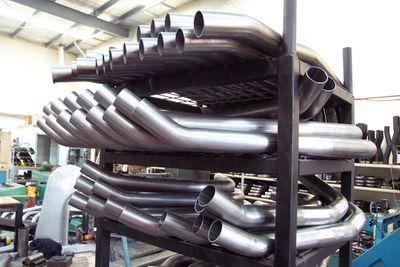What’s The Difference Between The Different Exhaust Pipe Sizes?
Here at Manta Performance, we have designed and built many, many exhaust systems for all types of vehicles. We offer systems that use 2.5-inch pipes, 3-inch pipes, and 4-inch pipes.
Which one is right for you and your vehicle? We’re glad you asked!
It all comes down to your vehicle and what you are doing with it
Manta Performance exhaust systems are specifically designed to get the most performance from the type of engine your vehicle comes equipped with. We can break all engines down into two basic categories:
- Forced induction – turbocharged or supercharged
- Normally aspirated
Then there is the difference between a 4WD and a street vehicle, such as your Commodores and Falcons. Let’s start with 4WDs.
Turbocharged engines on 4WDs need bigger pipes
Generally speaking, a turbocharged engine benefits from larger pipes – up to a point. Most Manta systems made for turbodiesels use 3-inch pipes. This provides several benefits:
-Faster spool-up of the turbos
-Improved gas flow
-More power
-Larger drop in exhaust gas temperatures
But there is a limit, and that has to do with the size of the turbo outlet pipe. In a vehicle like the 70 Series 4.5L V8, the turbo outlet is only about 2 inches across. This means that there are no extra gains from going up to a 4-inch pipe over a 3-incher. Another good reason to use 3-inch pipe is that in the event of any pipe damage that happens off-road, you should be able to find 3-inch pipe at most repair shops.
There is an exception to this rule, and it applies to twin-turbo engines like the one found on the 200 Series, as well as big displacement engines such as the 7.3L V8 on the Ford F250. A 4-inch system works well with these types of engines, giving you improved flow as well as a better sound!
Normally aspirated engines on 4WDs need smaller pipes
While a turbo acts as a compressor to pack more fuel and air into the cylinders, a normally aspirated (NA) engine must do without this upstream boost. These NA engines rely on a principle called exhaust scavenging to efficiently suck the exhaust gases out of the cylinders when the valves open.
What is exhaust scavenging?
Exhaust scavenging is a process that starts when your NA engine’s exhaust gases exit each cylinder and travel through the exhaust system as quickly as possible. The high speed of the departing exhaust gases then creates a negative-pressure area inside the cylinder, which works to pull more fuel-air mixture into the cylinder for the next combustion cycle. When the scavenging process is optimized, it’s like having a mini-supercharger on your engine.
Pipe size is critical here – pipes that are too large will reduce the scavenging effect, decreasing torque, slowing down the exhaust flow, and impairing the engine’s performance. Manta Performance exhaust systems are engineered to maximize this scavenging effect, boosting your car’s performance significantly.
Years of experience have led us here at Manta Performance to use 2.5-inch pipes on our NA exhaust systems. By maintaining the right amount of exhaust scavenging, the 2.5-inch pipe produces improved performance and preserves low-end torque, especially when extractors are added.
The same principles apply to street vehicles
For street exhaust systems, our guidance is the same as that for off-road vehicles. For turbocharged and supercharged vehicles, a Manta system with 3-inch twin pipes will flow over 800+kw, which is perfect for a blown powertrain or a vehicle with an upgraded cam. It also gives you a deeper, louder note.
For NA street vehicles, our 2.5-inch twin systems will flow up to 500+kw, which is ideal for a naturally aspirated engine. This is also a quieter option that provides less interior resonance.
What about header pipe sizes?
We are often asked, “What is the ideal header primary pipe size?” The right answer depends on the modifications made to your vehicle and how you plan to use it:
-For a daily driver, a 1 3/4-inch primary pipe provides great mid-range torque, while slightly reducing your top end power
potential.
-For blown engines and racing use, a 1 7/8-inch primary pipe gives you the best top-end performance, but you will lose some mid-range torque.
Bottom line, whatever mods you have made or planned, Manta Performance has the right exhaust system for you and your vehicle, wherever and however you plan to drive it!


